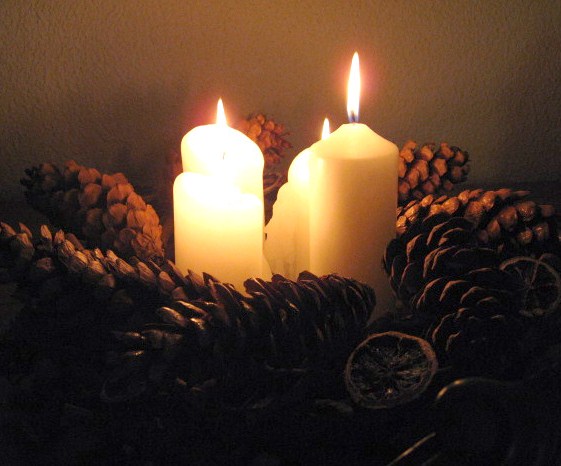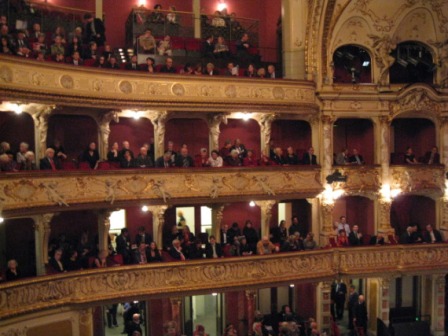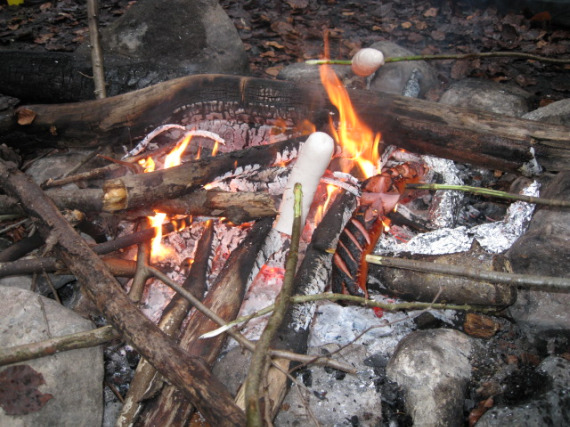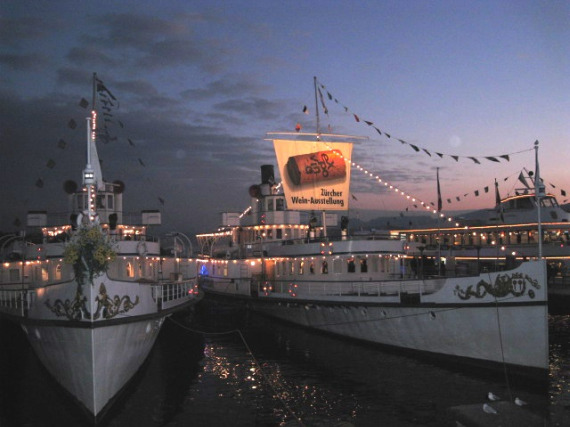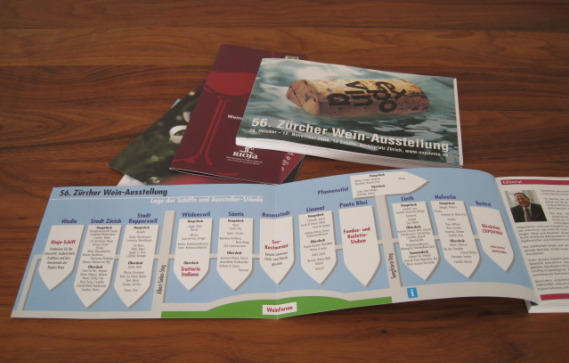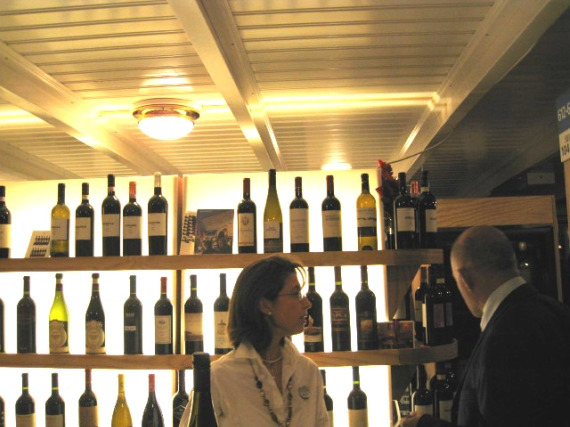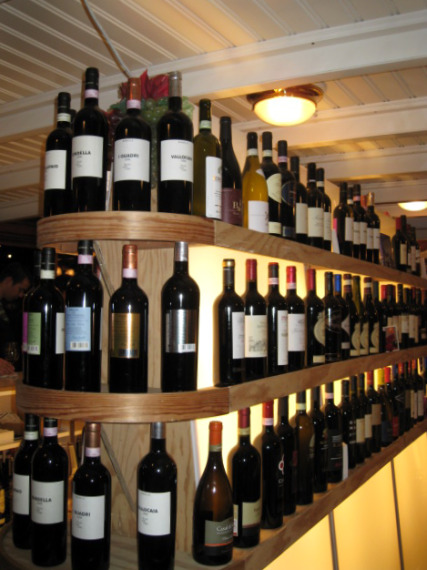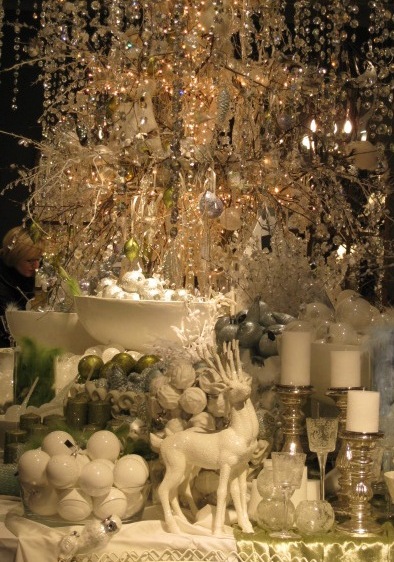Cinnamon, ginger, anis, clove….
All of these are the spices used for cakes and cookies for Christmas. Such aroma was floating in the air from the Central station building, Christmas markets and hot wine stands along the streets.
The period from the fourth Sunday before Christmas is called Advent in the German-speaking Swiss region, and everybody starts to prepare for the Christmas. People get excited and happy. It is just like the joyful but restless moments before the New Year in Japan.
We look for presents for each member of your family and relatives, which requires certain days to give each a different wrapping. Illuminations will be lit and big Santa will be on the wall in the house where children are around, and the wreath on the front door is another element to consider. I have changed my potpourri to the one of Christmas flavor. When I had my face close to the branch of the fir tree that was just chopped down, I could smell the cold and tranquil forest. This should be also arranged around the potpourri.
There were 4 candles for Advent. This year, one candle was lit on the last Sunday of November, and on every Sunday since then, the 2nd and the 3rd candles were lit. Today makes the 4th one to be lit.
While the classical decoration means ribbons or ornaments over the evergreen wreath, that varies depending on the family. Whatever color or design that you like. Since the first-lit candle becomes the shortest, some people design so that the candles will be of different height. Although we enjoyed covering the whole floor with tree branches and used blue candles last year, this year gave us a different mood.
We thought Sarabande might be suitable to listen, so we selected D major. In accompany with the slow melody of cello, we idly gazed at the shadows of the candles.
Outside is -10 degrees. Over the snow that fell last night, frost flowers are sparkling radiantly.
Christmas is just around the corner.
Leave a Reply
Every year, from autumn to winter season, we welcome guests from Japan who come at random. And usually they come here as treats for themselves, such as because they have just finished some project or it is the right time to have a break from work, and so on. Quite often they come as solo travelers.
Although these people may be quite demanding, they know what they want and are very independent. Therefore, it is fine to let them to be themselves during the day, as they know how to enjoy themselves. However, the problem is the evening part on how to make them satisfied.
If it is in the cold season, we would like to recommend some opera, after all. Therefore, quite often, their schedule may be slightly adjusted, after we go through the program beforehand.
Zurich Opera House is solemnly situated near the lake. At the moment, it is one of the hottest opera houses in the world. It is also known as one opera house where the performances shown from September to June are of top level and it is hard to obtain tickets.
In the fall of 2007, “La traviat” and “Der Rosenkavalier (The Knight of the Rose)” were performed in the Orchard Hall in Japan. It was a hot topic of town as excellent opera singers were lined-up lavishly on stage.
The Aktientheater build in 1834 was the predecessor. It was the venue where Richard Wagner, who went into exile in Switzerland at that time, demonstrated his talents. Even now, I understand that there still remain quite a lot of musical notes of Wagner in an antique shop near the university. This theater was burnt down in the past, and the current Zurich Opera House was build in 1891. We understand that eminent big-time masters such as Wilhelm Furtwangler, and Richard Strauss, as well as Wagner were hired to perform on the stage, and the success and its reputation overwhelmed the Europe.
The House accommodates 1100 seats. Although the exterior and the interior are beautiful and massive, it is rather small compared to the counterparts of Paris and Vienna. It is just like a cute princess.
However, the convenience of the location and the economic power of Zurich play a great role here. Furthermore, the country has 4 languages and English is spoken normally. There are many people who speak 2 or 3 languages. Among my Swiss friends, some has an excellent skill to switch languages whenever she goes across the border within Europe. It is a great advantage not to have a language barrier. Italy, Germnay, Austlia and Easter European countires. Each program has the world’s top class singers all lined-up. This town has all the required conditions to attract and focus on such vast range of talents.
The Opera House welcomed Alexander Pereira, present General Manager, in 1991. Since then, under his firm leadership, the Opera House has been gaining the momentum year after year.
The annual performance repertory holds 32 to 35 performances, 15 of which will be totally new interpretations. While it indicates that at least 1 performance will be a new one per month during the season, it is considered almost impossible frequency in the general opera world.
Franz Welser-Möst, who was appointed as the Chief Conductor in 1995 and served as the General Music Director since 2005, will become the General Music Director of the Vienna State Opera in 2010. This position was suceeded by Italian Daniele Gatti in June this year.
The curtain opens at 8 o’clock. We left our coats at the cloak, and we are at the lobby holding the pamphlet in hand. Our seat is the balcony on the 2nd floor, which is our favorite.。
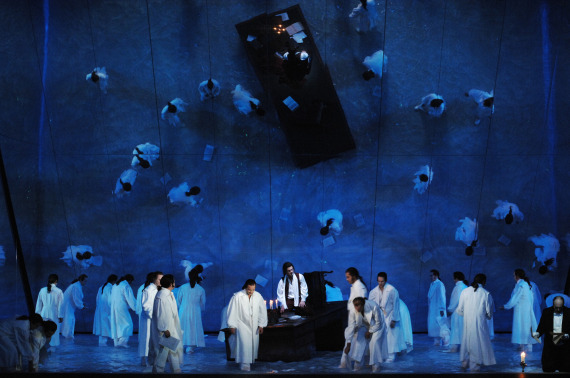 Photo: Opernhaus Zürich/ Suzanne Schwiertz
Photo: Opernhaus Zürich/ Suzanne Schwiertz
The production is Verdi’s “Corsaro.” Corrado, the chief corsair, is performed by Vittorio Grigolo who is now on the rise. His lover Medora is performed by Elena Mosuc, female slave Gulnara by Carmen Giannattasio, and Seid who loves her, by Juan Pons. Grigolo who stands between two sopulano is just perfect.
Last fall, by using the Zurich central station building as was, involving the people after work and the audience, “La Traviata” was performed and simultaneously broadcasted on TV. The singer who played Alfredo there was this Grigolo. While he was a wonderful singer, it was interesting to see a glimpse of his mischievous character during the interview, which made me his fan, anxious to listen to his voice in other performances.
Furthermore, in this performance, a young Japanese tenor, Mr. Shinya Kitajima, made his debut in the role of Selimo. Later on, I had a chance to talk with him.
“While I was lucky to have such wonderful co-performers, the reason why I was able to perform the premier without being too nervous owes a lot to the unique warm atmosphere of this Zurich Opera House, I believe.”
I think these words of Mr. Kitajima represent the characteristics of the Opera House.
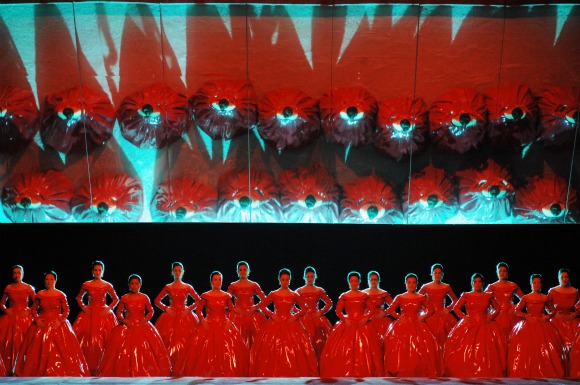
Photo: Opernhaus Zürich/ Suzanne Schwiertz
Alexander Pereira, the General Manager, often says, “As far as it is faithful to the story, I belive producers are fee for any adventures.”
As for the “Corsaro” this time, when I asked the support members of the Opera House, most of them responded that they had no idea since the conductor and singers would be performing for the first time and the program was rarely performed.
However, day by day, reputation brought another reputation, which resulted in all fully booked performances.
Especially we noted the originality of the choreograph, such as the water on the whole surface of the stage to reflect on a huge mirror, sophistication of lighting and perfect tempo, all of which never bore us. Surprises and unexpectedness developed one after another.
We stepped out into the balcony holding champagne glasses at the interval. Although the glitz of the lobby was nice, the heat of the stage directly came into the air, which overwhelmed us. Cold night breeze was so refreshing.
Having the 6th curtain call, the opera house was filled with another roar of excitement. For this type of challenging and dynamic stage, the audiences gave generous applause. The high quality of such audience is also, I believe, a sign of high recognition in the world of opera house.
014jpg
http://www.opernhaus.ch
Leave a Reply
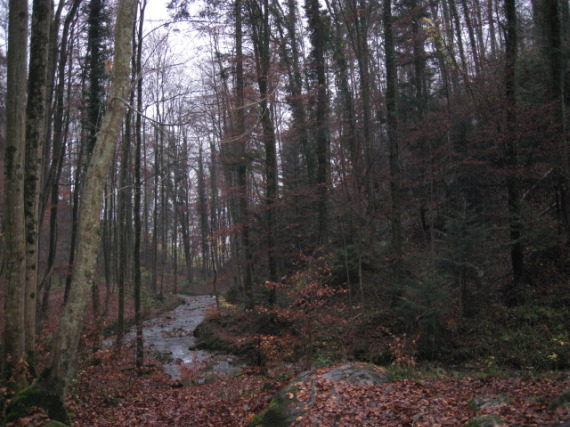
One Sunday afternoon, I had a chance to go to the forest.
Although the Lake Zurich is nearby, you can easily access to the forest within walking distance from the central area of the city. Walking or jogging in the forest has become part of our daily life here.
The place I went this day was along the shore of the Lake Zurich. The forest was stretched out near my friend’s house. “Well, the weather turned out just wonderful,” a smiling blond intellectual-looking young man said, looking up the rainy sky.
Holding hands with a small boy wearing rain boots, singing German song that I had no clue what it meant, we climbed up the hill slowly, by walking over the fallen leaves. When we turned into a small lane, my tip of nose sensed something refreshing. I breathed in the deep smell of the forest. Once more, I breathed deeper. Numerous lofty trees connected the earth and the sky.
The moist air from the drizzle in the morning fallen on the ground, and everywhere was filled with this moist air. When crossing the stream, you could feel some slippery touch underneath the shoes. Big and small pebbles here and there were covered with soft moss. They walked through easily by stepping the stones one after another. Once in a while, small breaking sounds of twigs were heard.
Today’s goal is to make a fire in the forest, and to grill big sausages called Bratwurst.
We all spread out in the forest to find some long branches. What would happen to someone like me who had never had anything to do with the life in the mountains or forests, when participating in such an unfamiliar event and faced such an unknown situation?
Feeling simply impressed with the fact that these people have been living in touch with nature since their childhood, and at the same time, being fully aware that I would be no use here at this moment, I silently became the keeper for the Bratwurst. No, it may not be true. As a matter of fact, I did not know what to do. I was just wandering around.
While the army knife of VICTRINOX is well-known in Japan, everybody here has a well-used knife of his own. Taking them out of their pockets, they skillfully made skewers by sharpening the tip of the branches.
I have heard about the story that Swiss children go to barbecues by carrying one sausage of their own, and now I realized this would be the adult version.
It might not be wrong to say that most of the people working in Zurich spend their weekends in the forest in a varied form of this kind.
I wondered if this was the forest frequently visited by the people in the neighborhood. Stones were already piled up. We saw branches of beech tree, larch, and popular and so on. While placing thick trunks, we horizontally poked each “own” Bratwurst into the sharpend tips of the branches mentioned earlier.
Although I felt poking them vertically would be easier to eat, there must be some reason whey they placed them horizontally. Everybody had their own way of making cuts on their sausages. That, also might be their tradition of each family.
Let me repeat, you grill you own. More specifically, you change the angles to roast. Sitting on a fallen tree, by checking the directions of the wind and smoke, you put out your stick over the burning fire.
I found a big stone nearby which could turn to a table. When your own Bratwurst turns to nice brown color, just take it there.
Now I somehow understood the reason whey they had been placed horizontally, instead of vertically. However, they took them out of the sticks. Nicely browned Bratwurst sausages were, of course, very hot. But they grabbed them by hand to eat!!
Still this way of eating food exists in the present time, like a tail of ancient days. What a primitive but wonderful way. To me, grabbing the food to eat in a situation like this, looked very cool. Feeling the closeness of comrades, I simply imitated their ritual.
Around the fire, tranquil and comfortable time went by.
Out of nowhere, appeared some boys with flushed faces. Although this area is not far from town, there may be some secret lanes deep in the forest for these boys.
Leave a Reply
Connoisseurs of fine wines may know this. There are many great wines in Switzerland. Furthermore, as the types and characters of grapes vary depending on the area where the language is spoken, a vast variety of wine was born.
When I went to the jazz festival in Montreux, I had a chance to taste the white of Laveaux, which was just wonderful. Well-known places for white wine using Chasselas grapes are Vaud near the Lake Leman, as well as Valais in its south and along the Lake Neuchâtel near the French border.
When you talk about the red, white and rose of Merlot, it will be Ticino in the area where Italian is spoken. Where you can find wines that share similar tastes of Pinot Noir or Pinot Gris from French Alsace, or that from Baden in Germany, will be around the Lake Zurich and the western Switzerland. Just for your information, we also have what we call, Zurich wine.
I hear that some grapes that were planted in the Roman Era are still grown. It is really amazing to know that tens of different kinds of grapes are grown in the wine regions in this country which is about the same size as Kyushu.
Why there aren’t many Swiss wines in Japan where gourmet foods collected from around the world?
That is because the Swiss love wine very much. It does not mean that we do not export any, but since the people here drink wine 3 times the quantity of the domestic production, as a matter of fact, and the shortage has brought more and more imported wines. I thought that they did not want to share something delicious with other countries, but now I understand what the reason was. First of all, the grapes grown on the land where machines are hardly used because of its steep slopes, are only picked up by human hands, and also because it requires lot of traditional manual methods to make wine, they are overwhelmingly in short supply.
It seems like these conditions are the background. For the 2 weeks up to the mid November, just to be in time for Christmas, Zurich holds a large-scale wine exhibition every year.
From Bürkliplatz where Old Town and the financial district meet, not only sightseeing boats but also commuter boats run to various places. The annual EXPOVINA, commonly known as Weinshiff, is held here, by having 12 boats lined-up and anchored at this old pier near the Lake Zurich. It is open to public and it is the world’s largest wine expo. It stared in 1953 and this year celebrated the 56th anniversary.
More than 120 booths of wine producers and importers, were set up in the 12 boats. When it comes to the number of different types of wine, it will be easily 4000 at the least.
Carrying the catalogue given at the entrance, you go around the booths you wanted to try, and after tasting, you check those names corresponding to the booth numbers that you liked, to put down the points.
Having visited several times in the past years, I thought I was starting to get the hand of it. However, since the number of displayed wines is tremendous, it is too audacious to think about completing the tour of the whole 12 boats including the one that turned to a Swiss restaurant, in a single day. Your tongue, nose and inside your mouth will become blunt for judgment, or in other words, in my case, you cannot trust your taste buds any longer.
This year, there was somewhat unusual Spanish Rioja in the very left boat, but since the boat was swinging due to its small size, we moved on quickly to the next boat. Although other boats were anchored steadily and no worries of sea sickness, once you started from fruity white, by listening to the explanations by the dealers, and moved on by thinking “Well, next I should try a little heavier red” and so on, you would feel too great and your spirits would be high after you have tried the 10th one.
First, I went with my friend who was a wine-tasting professional to go around. However, I did not decide on certain label that day, and went back again on a different day for more focused direction, to try some interesting ones that I usually do not drink.
What we wanted to go after was German white. Baden, Pfalz, Saar, Rheinhessen, Rheingau, and Mosel, we tasted along the Rhein. While I always thought that German wines were sweet, tasting those wines made me realize that my knowledge was too premature. There were many bottles that demonstrated refreshing, deep, and elegant tastes.
Finally what we decided was Sheurebe of Mosel and Riesling, as well as a sweet one of Sheurebe which gave us the impression to be the one to taste after the Christmas dinner.
Although 6 bottles were the minimum to order in general, some booth started to be more flexible so that we could mix 6 different bottles for one order.
It was Friday night. In addition to some relaxed couples, people after work started to join us.
Very attractive 2 women, assumed still in their 20s, were asking the dealer many detailed questions one after another. Over there, one young man with backpack was taking notes, while a senior couple was relaxed and enjoying the conversation at the counter, checking the list.
We moved around the Swiss wine section, but the surroundings of popular wines turned into a place for social interaction. It was so jammed that we changed our direction to Italy.
Although the order was totally reverse, we were able to take a break with chilled Prosecco, an Italian sparkling wine, which we casually order as aperitif in restaurants in Zurich.
We sorted out our cellar in the basement to welcome those wines we ordered, but still waiting for their arrival.
Leave a Reply
It’s a beautiful sunny day. The snow-capped Alps is showing off its crisp elegant lines.
Long nights are already here and it gets dark already at around 5 o’clock in the afternoon.
When I was walking in a hurry, looking at the roast chestnuts vender out of the corner of my eyes, I notice that one Christmas illumination has just been turned on. Where this small full light came from was deep in the cobblestone lane. The street in front of the station where the tram runs changed to a sort of blueish light of modern art 4 years ago.
Ladders were placed against the humongous tree in front of the huge bank building, and you could see many shadows moving, carrying big red or gold balls.
Since it is time for occasions that you dress up more frequently, the evening gym is getting more and more crowded. The festive season with continuous heavy meals is just around the corner.
I am getting nervous again, as I fear of my ritual failure. It seems to happen just before I am ready to go out, when I put on the clothes I have planned to wear, and they look something different than I thought would look.
The gym I go is just an ordinary one, but it is convenient as it is located in the center of the town. Furthermore, it is the area where many ethnic groups of people live like a compacted Zurich, in which environment I feel comfortable as a foreigner.
As a variety of people from various parts of the globe gather together here, you will hear many languages such as English, with various accents, German, French, Italian, Spanish and Swiss German.
Zurich is a city I expected to be conservative and low-keyed. However, once I started to come and go through this locker room, my impression has dramatically changed.
Especially this time zone, it is totally different from daytime. The age group becomes much younger, which adds some sort of glamour.
A fashionable madam is getting ready to leave by looking at her watch. A young woman who looks like a model, is looking at herself, standing in front of the mirror, with her chin up.
As the neighborhood is the financial district, some of the members may be working for such institutions. Sooner or later when the weather gets colder, it is quite a site to see all those fur coats lined-up on the hangers.
While every visitor from Japan says this is a sophisticated town, just looking at some fragment like this, might be convincing enough for you that it is a rich town.
As I had a little shopping to do, I rushed into one department store just before its closing time, carrying my half-finished bottle of Evian.
Some modest little present to my friend.
Many people seem to have decided on the color or design for this year. So I hesitated a bit, but I picked up for my table one cubic candle in the color of off-white, among the Christmas ornaments.
Winter rain has started to fall now.
Leave a Reply
My Swiss female friends are very good at wearing scarves.
Simply tying a scarf around your neck over a white blouse or a cashmere sweater is a standard style that everybody knows. I don’t recall exactly when, but once I saw a woman simply spreading a large pink Hermes scarf over a dark brown jacket, which really impressed me with the interesting color combination. It matched very well with her blond hair.
Although I know it will cheer you up when you wear something in vivid color on a cloudy day, I always tend to pick up something very dark.
As we are expecting a long winter now, I went through my closet to find some colors for accent.
There is one scarf that has been left at the same place since last year. Although it is true that I have been treating it as something special, it has become difficult to put it on once you lost a good timing. So it has never been outside my closet.
There is one nice shop that deals with good quality textiles along the lake. I casually drop in each season as they carry or produce something unusual.
That was surely one afternoon of early winter. The antique room must have been at least 150 years old. When I was talking with the designer at one corner of this room, I just realized this scarf was simply placed by the windowsill.
It was a mysterious lace that revealed many colors though the light. When I got close to it, it was a cloth just like the wind.
When I picked it up to take a look, she happily smiled at me.
She said, “It is a lace from St. Gallen. I, myself, found it. It is really a great piece of work. I believe how you use it, is just like how you wear a piece of jewelry”.
St. Gallen. If you hear this place name, a meddeval town comes to your mind right away.
It is located in the east of Zurich, about 1 hour train ride. Up to the area around the monastery, which is believed to be the masterpiece of baroque architecture, the town has a splendor scenery and is designated a World Heritage Site. While it is well known as a town of academics, it is also once a prosperous town with long history of textiles, laces and embroideries.
A lace of winter color sent from such a town.
There were enough reasons to purchase that.
Leave a Reply
![]()
Tracking Happiness, 2009 Production still © Mircea Cantor
The image of the women walking slowing carrying brooms has been stuck one corner of my head. That motif has been appearging and disappearing. Now it seems like I am trapped in the trick of this artist.
Mircea Cantor.
Things that have crept into our daily lives before we know it, and that have become our patterns unconsciously, but make us suddenly wonder why or bring some uneasiness.
Our everyday common scenes disturb our daily lives.
Tracking Happiness is also the title of the film that Cantor created for this exhibtion.
Wearing pure-white clothes, they move slowly barefoot in the soft sand like dancing.
We are not sure what the purpose is. They walk endlessly like wandering in a dream, and the footprints are erased clean by the brooms.
Strangely blight with the grainy light exposing the empty space, the women link to the image of angels, in a dimension different from the present.
They chase things left somewhere unnoticed, or things that have been erased. Or they trace their footprints in a different way.
It reminds us of the present age that we are under the control of communications by computers or electronic devices. He tries to establish a different reality, against the world where private information is accumulated, multiplied and disseminated, which he says is also his bewilderment.
The work includes various media such as video, photographs, objects, installations, etc. Cantor also takes advantage of the media incorporated more in the society, such as newspaper ads, as one method of expression.
Born in 1977 in Rumania, he currently lives in Paris.
His solo shows at Camden Arts Centre in London and Pompidou Centre in Paris were sensational and stole the scene of Europe. Now for the first time in Switzerland, his one-man show has opened.
Until Nov. 8, 2009
Photo: Kunsthaus Zürich
http://www.kunsthaus.ch/
Leave a Reply
021
Close to the Cathedral, there is one shop I drop in occasionally when I stroll on the stone-paved streets of the old town of Niederdorf.
Stefi Talmam.
While she is considered as a Swiss designer who is capable in the wide-range of fields from architecture to typography or industrial design, she is also a well-known cutting edge in the fashion field.
Her collection is interesting and has surprises in the color variation, mainly in the shoes and bags as well as small items and accessories that decorate the windows. Especially, the combination of the leather used for the base and colorful unborn calf. It is amazing to see the well-thought combination balance of humor, intelligence, and functionality.
Since mid 1920’s, most of the people who have been innovative in the design world of this country are those who had moved to Switzerland from overseas. Stefi is no exception. She is a cosmopolitan of European and Asian origin.
While incorporating sharp and simple conventional Swiss design, targeting to the working women with borderless sense is probably, I believe, very Zurich like.
She has established popularity among assertive Swiss women, and has many fans in USA and Asia as well. http://www.stefitalman.ch/
Leave a Reply
007-a
Geographically speaking, it is in the south-southeast of the Lake Zurich. This side is called Silver Coast, contrast to the Gold Coast of the other side of the lake. Because the sun shines by grazing the mountains, shadows are darker. The light is somewhat dreary, and the streets of buildings with beautiful neo-classical carvings are full of stories. Although there must be a lot of stories to tell, the streets seem to trap us into puzzles to be solved whenever we walk on the streets.
Getting off the tram and walk to the left. After passing the iron-gate on the slope, and on the top of a small hill, you will see an elegant villa build by Otto Wesendonck, a successful silk trader in the mid 19th century. This mansion is the old wing of Museum Rietberg. The building right in front of that is the new wing and most of you who are involved in architecture may be familiar with this building since it has held world-class competitions.
The collections of Museum Rietberg include Oriental, African, American and Oceanic arts, and this is very unusual for an European museum.
However, that is the part where you find the Swiss folklore art, and I realized for the first time at this exhibition of Performing Masks Swiss Carnival, which displays carnival masks, that the museum has an enormous permanent collection of Swiss masks.
image2_640_480
Carnival mask, Tschäggäta Switzerland, Lötschen valley, early 20th century
It was the time when I was wondering where the mountain people are now. One day by chance on TV, I saw the people who were walking through the field of snow, by wearing huge masks that were hard to tell whether they were those of animals or humans.
I was told it was a traditional local festival called Tschäggätä in the Valais region, to get rid of evil spirits. It is held on the Thursday before the Ash Wednesday in February. It is very interesting because the way it looks and the custom to wake up children by visiting houses are similar to the Japanese Namahage.
Although there are various stories as to the masks, it is said that the masks used for this occasion is the oldest ones in Switzerland. Because their facial expressions are too fantastic, super-human and mystic, it had already attracted the attention of ethnologists by the end of the 19th century.
image1_640_480
Museum Rietberg Zurich Carnival mask Carver: Albert Anton Willi (1872-1954) Switzerland, Domat/Ems
Furthermore, the masks in the Salganz region where Rumantsch, one of the Swiss 4 languages, is the official language, have the characteristics of rich expressions which extend vertically and horizontally. When I was going through the exhibition catalogue, I found one photo where Mr. Albert Anton Willi, who was a sculptor in this region, was putting an expression of a mask on his face in front of a mirror.
007-p
Many of the masks displayed this time are made by curving woods and coloring, by using animal skins, sheep -skin and textiles and so on. While there are 3 major regions where the masks are handed down through generations, it is overwhelming to see the enormous variety of expressions. I wonder this tells us that individualism were accelerated more in the days when the nature was severe and the people had to live in the environment where communications were cut off due to the rugged mountains.
In this country surrounded by the mountains, religions before Christianity was brought in, or faith before religion, have been affected in various ways by the surrounding countries. In some regions, they have integrated with Catholicism and re-grown as individual cultures.
Awe and respect for huge mountains. I hear that the roots of many mythologies and legends can often be found in the regional festivals.
From the Alpine mountains or deep in the forests, in the room deep in the museum, the sprits are conspicuous.
http://www.stadt-zuerich.ch/kultur/en/index/institutionen/museum_rietberg.html
Leave a Reply
Director, Terry Gilliam, appeared on the red carpet.
Zurich Film Festival has been a focus in recent years as one of the distinctive film festivals in Europe. The Zurich Film Festival has celebrted its 5th year. More than 60 films from Switzerland and other countries, including those big pieces considered to be the greatest in the movie history, are being shown here.
The competition consists of 3 sections; International Feature Films, International Documentaries, and German-language Films. Apart from these films, you can enjoy a wide range of various films such as digital films and short films.
USA, Mexico, Israel, Russia and Korea, as well as European countries have participated. Especially this year, several films from Argentine have attracted attention.
While it is aimed to find and promote unique expressions and excellent talents from all over the world, it can also be said that it is a film festival based on the originality and home-court advantage of Zurich where young ambitious filmmakers can easily get together
Related events and workshops by young producers were held in various venues. Furthermore, the speeches by Morgan Freeman, Michael Keaton, Peter Fonda and so on are also included in the program.
“Golden Eye” is an award given to excellent moviemakers.
Although the news of the arrest of Roman Polanski apparently might have made this film more visible, the “Golden Eye; A Tribute to…” was awarded to Mr. Polanski. At the same time, it was announced that the award ceremony would be held in his absence, based on the firm appreciation of his achievements. The retrospective is being held according to the schedule.
RTEmagicC_Freeman_3_jpg
The “Golden Icon” Award which can be said as a lifetime achievement award, will be given to Morgan Freeman who appeared in the films such as “Million Dollar Baby,” “The Shawshank Redemption,” and “Driving Miss Daisy.”
Until October 4, 2009
Photo: Zurich Film Festival
